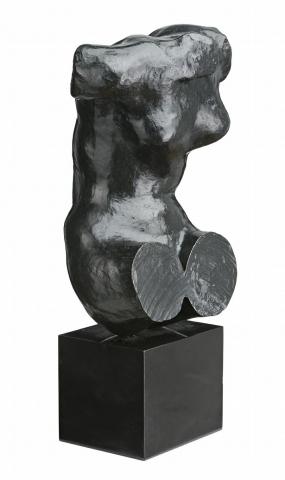SEATED FEMALE TORSO (TORSE FEMININ ASSIS), CONCEIVED BETWEEN 1880 - 1899 AND CAST IN 1986
Auguste Rodin
bronze with brown patina
34.0 cm height
signed and numbered on left thigh: A. Rodin 5/8
inscribed on underside of right thigh: © by Musée Rodin 1986, stamped with foundry mark
Accompanied by a Certificate of Authenticity, signed by Jacques Vilain, Curator at the Musée Rodin, 1988
Musée Rodin, Paris
David Jones Art Gallery, Sydney
Acquired from the above by Mr Neville Gruzman, Sydney, 1988
'The artist worthy of the name must express the entire truth of nature, not only the truth of the outside, but also, and above all, that of the inside...'1
In a manner akin to his much-celebrated Gates of Hell, Rodin's use of the partial figure in sculptures such as the present stemmed from a fundamental desire in both his art and life to not only harmonise the outer world with the inner, but to connect past with present. Perceiving himself as descending from a long tradition of sculptors faithful to the lessons of the ancients, Rodin was a notoriously passionate collector and devotee of Graeco-Roman antiquities - so much so that he would often deliberately mutilate his own works to accentuate their resemblance to the achievements of his predecessors. In particular, the French sculptor admired how the fragmentary, often incomplete condition of ancient marbles in no way diminished their beauty or expressive power: 'Here is a hand... broken off at the wrist, it no longer has any fingers, just a palm, and it is so true that to look at it, to see it alive, I do not need the fingers. Mutilated as it is, it is still sufficient in itself because it is true.'2
Yet if his partial figures - or 'parcels of truth' as the artist affectionately described them - served to inextricably link Rodin with the past, paradoxically perhaps, they also constituted his greatest connection with artists of the next generation. Audacious in their broad simplified planes and amputated forms, it was from such works as Seated Female Torso, that modern sculptors including Maillol, Brancusi and Archipenko would find authority to truncate and otherwise simplify their figures. Indeed, just how provocative and influential Rodin's morceaux would be for abstract figurative sculpture is encapsulated by the impressions of Jacques Lipchitz upon visiting the new Musee Rodin during, or just after, the First World War:
'My joy was immense, and so was my enthusiasm... I was struck by a certain aspect of some of his sculptures. Probably influenced by the sculptures from his collection of ancient art, he had created what might be called 'torsos'. These figures without arms, heads and legs were endowed with a sense of mystery, and one needed imagination to complete the figure. I did not want to make 'torsos', but at that moment I understood that a work of art needs the element of mystery. I clearly saw that what Rodin was doing instinctively was not so different than what we, the Cubists, were doing in a more intellectual way, and that at certain points it was even more complex.'3
1. Rodin in L'art / Auguste Rodin; entretiens réunis par Paul Gsell [1911] Dover Publications, England, 1984, p. 81
2. Rodin, 'La Leçon de l'antique', Le Musée, Revue d'Art Antique, 1 (1) January - February 1904, pp. 15-18
3. Lipchitz cited in Elsen, A., Rodin. Homage by Jacques Lipchitz, Museum of Modern Art, New York, 1963, p. 5
VERONICA ANGELATOS
